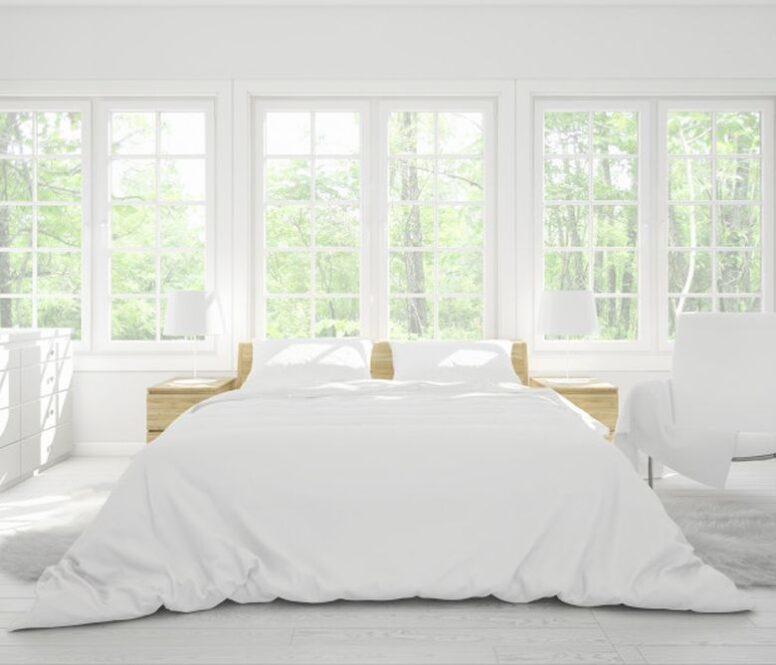Sleeping well at night is crucial for a healthy and satisfied life, and we literally mean sleeping well in the physical sense and not the mental one where you worry. Having enough comfort in your bed that is made up of the frame, mattress, pillows, and covers you enjoy and which gives you pleasure is sadly not something everyone experiences. Sooner or later most people buy themselves quality sleeping solutions but it often takes years of bad sleeping habits and poor items and products before we finally start to enjoy it. One thing that can greatly help you towards reaching this stage of life sooner is a duvet.
This bedding can be all you really require for a quality night of sleep no matter how tough your nights could get and how long it takes you to fall asleep on average. In this article we will examine the most important factors you have to think about before you buy yourself a new duvet. We must tell you that you should definitely have one in your home since it is a very beneficial and useful thing for sleeping. Therefore, think of this article as a guide and make sure to check out Better Nights to learn more and browse a great offer of products.
What is a Duvet?

Before we give you the crucial factors worth considering when buying one, we must first talk about what exactly is a duvet. This is a type of bedding that is made of a soft flat bag that can be filled with various things. Most often, it is feathers, down, wool, silk, or cotton that acts as the filling and different fillings are used for different duvet types. It is used to cover yourself while sleeping and it is usually covered with a case just like a pillow case goes over a pillow. It is often used without top bed sheets and it can be enough in warmer weather, from the end of spring towards fall. First duvets appeared in rural Europe centuries ago as people would fill long cloth bags with duck feathers. The name for this bedding is French, and the word translates to “down” in English. American English has another word for it, they call it a “comforter” and it really does allow for more comfort while sleeping, although other bedding covers can also be called comforters.
How to Choose

Since you now know the basics of duvets, it is the perfect time to talk about the important factors you will have to consider before you buy a duvet. There are different types of sleepers out there as people tend to have different tendencies when it comes to comfort and positions during the night.
Warm sleepers will get hot too easily and need covers that will allow them peace without constantly looking to cool themselves. Normal sleepers are low maintenance across the board and they have no problems with falling asleep anywhere or anytime. Cold sleepers are the opposite of warm sleepers and they are never warm enough, even if they have a few blankets or covers over their bodies.
If you are constantly warm, you will need a light warmth duvet. Normal sleepers will be fine with the usual, year-round warmth duvets. Cold sleepers will need extra warm duvets though. This distinction is the most important factor to consider because the last thing you want is to invest in a quality item and then have little use of it. Following are things that directly relate to the different types of duvets.
1. The Filling

As mentioned somewhat earlier, a duvet can be filled with various different things. Most contain down, silk, wool, feathers, and bamboo, which are all natural. Synthetic microgel is also available. Down is that little type of feather underneath the true feathers on birds. Duck down is light and small, making it good for those who want it cool. On the other hand, goose down is larger, warmer, and more insulating.
With silk and bamboo, the two hypoallergenic solutions, you will have the best experience when it comes to sensitive skin and/or allergies. Both are great at insulating and they battle moisture amazingly well. For a cool and dry sleep, go with either, but know they behave well when more warmth is needed too. Wool is great at dealing with moisture and therefore best for a dry and fresh sleeping environment. Since it is heavier and denser than other materials, it is good for winter and year-round duvets.
Synthetic solutions are heavier because there needs to be more filling, but they are warm enough and hypoallergenic. They are also very easy to clean and take care of.
2. Ticking/Shelling
The outer casing of your duvet (ticking, shell) plays an integral part as well and you can easily tell how good it will behave or suit you based on its thread count. Those with a higher thread count than 220 are considered down proof, meaning no down (or perhaps other material) can fall out and escape. In addition, the more threads there are the softer and lighter the casing fabric of the duvet is. If you care about the hand feel and how comfy it feels, opt for the highest thread count you can find. Alternative fibers like bamboo can also be used, which is better for warmer sleepers and better temperature regulation.
3. Construction

Duvets can be constructed in a few different ways, but the best technique is the baffle box, a grid of boxes. The boxes contain equal amounts of filling within and allow even distribution and cold or unfilled spots in the whole cover. Stitched box is the second most common way to go where the grid goes through both layers. Here though, there are often cold spots along the lines of sewing since there is less filling there and their compression is worse. These often look better however and chances are you know exactly the type of stitching we are describing here. They can also be good in warmer weather when you need cooler spots.
4. Other Layering
Last but not least, it is smart to think about the rest of the layers and fabric you may already be using. If you have a lot of other covering, you will hardly need a warm duvet, and vice versa. Having coverlets, flat sheets, and especially thicker blankets on your bed means you will hardly need anything else. Therefore, if you still need or want a duvet, pick a lighter one from the selection. Mind that the duvet case adds even more weight and warmth so account for that too when choosing.

